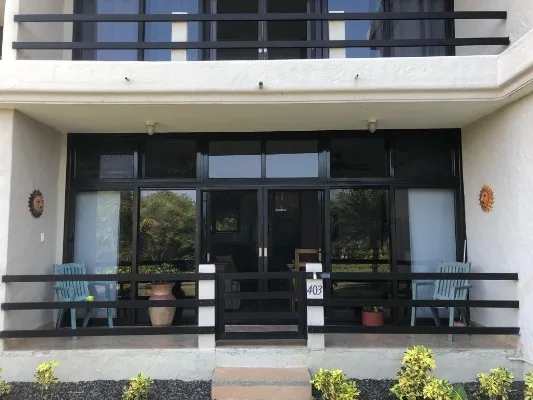Observations of an expat symphony goer — Cuenca concert crowds are changing
One of the joys of living in Cuenca is the opportunity to enjoy the concerts by both the Cuenca Symphony Orchestra and the University of Cuenca Symphony Orchestra.
Just last week, for example, the University Orchestra presented a concert Thursday evening at the Catredal Vieja (Old Cathedral) and the Cuenca Orchestra presented a concert Friday evening at Teatro Pumopungo. We had the opportunity to attend both, and enjoyed them. The quality of the performances we have attended has been exemplary.
Several things about the concert experience have recently changed. First, the number of people in the audience has increased. While the predominant group attending concerts still appears to be expats, the proportion of white faces seems to have increased. I don’t know if that is because there are more tourists in Cuenca or if more expats are discovering the concerts.

Cuenca Symphony Orchestra
A corollary to the increase in the number of expats is the establishment of a line of patrons waiting for the door to the Old Cathedral to open before the concert. Until recently, concert goers showed up about ten minutes before the concert was to start, entered, took their seats, and waited for the music to begin. For recent concerts, a line has started to form forty-five minutes before “show-time,” stretching around the block.
A casual glance around the concert hall shows about the same percentage of white faces that one would see at a Republican Party meeting in Mississippi. The Cuencanos continue to show up at the concert between the scheduled starting time and twenty minutes after the scheduled start time.
The line to get into the concert puzzles me. The acoustics at the Old Cathedral are excellent and one can easily hear the music from any seat in the building. That means the ability to hear the concert is not a significant reason to arrive early. The floor is flat, so once one takes a seat beyond the sixth or seventh row, it is difficult to see the members of the orchestra without a lot of neck-craning..That means the ability to see the performance is not a significant reason to arrive early for many people..
I can only assume that there are reasons not related to the concert. For example, it seems that recent arrivals to Cuenca have brought their highly developed sense of “time press” with them. I remember when I thought that arriving ten minutes before a scheduled event was being late!
After living in Cuenca for only a few months, I had relaxed a little about the emotional press of time, and while not yet having fully adopted the Latin concept of time, I no longer have the need to relieve the jittery worry about being late long before the actual time on the schedule. The change has already begun to feel liberating.
Of course, there is a self-fulfilling prophecy that comes with early arrival times. Since people see a long line before the concert, they tell themselves that they have to “get there early or the good seats will be taken,” and arrive even earlier than before! Others see them in line and promise themselves to get there earlier next time, too. I can imagine that in the not too distant future, expats will be lining up at noon for a concert scheduled to begin at eight in the evening, while Cuencanos silently shake their heads in wonder.
Another reason for the lines could be an opportunity to chat with other expats. For those who long to communicate with fellow countrymen and countrywomen when visiting a foreign country, it offers a chance for fellowship, to meet new acquaintances and renew existing relationships.
A second change has been the ever-more casual dress of the patrons. It wasn’t too long ago that concert goers dressed for a night out at a special event. Now, it is uncommon to see male patrons in dress slacks and button down shirts, let alone suits and sports coats. Jeans and casual shirts seem to be the uniform of the day, particularly for expats.. Women have similarly begun to dress more casually, but typically better than the men in the audience.
That’s not necessarily a bad change. Wearing more comfortable casual clothes means that more people will feel comfortable attending the concerts. It makes classical music less intimidating if you don’t have to put on a tuxedo and evening gown to hear an orchestra play music composed by the masters. It opens the event to more people and exposes a new group of listeners to compositions not usually played on the radio.
A third change I notice is that, because a new group of patrons has begun to attend the concerts, there are a lot of people in the audience who aren’t sure when to applaud. Traditionally, the audience does not applaud between movements in a piece of music. To do so interrupts the flow of the piece, changes the mood of the piece, and is disconcerting to and disrespectful to the conductor and musicians.
It definitely is not a mark of a music “snob” to follow this custom. It is an indication that one respects the music, the conductor and the orchestra.
It isn’t always easy to tell when the music stops due to the end of one movement and the beginning of the next, and when the music stops because a piece ends, especially if you don’t have a program of the concert. Perhaps the easiest way to tell is to watch the conductor. If the conductor continues to face the orchestra, the music is between movements and applause is not called for—no matter how emotional the music has been. If the conductor turns to face the audience, the piece is over and applause is in order.
The Cuenca Symphony Orchestra, the University of Cuenca Symphony Orchestra and the distinguished invited soloists performing at the many concerts available free to the public deserve to be supported. It is gratifying to see the increased number of patrons now attending the concerts. Let’s keep it up and let the city, the university and the musicians know how much we appreciate them!


















